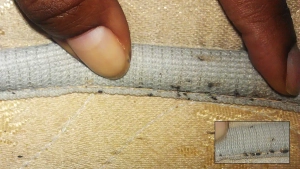Bed Bug Mattress Cover
A bed bug mattress cover provides a barrier between you and the bed bugs, but you must select the right one. Bed bugs are attracted to the carbon dioxide emitted when you sleep, making your mattress an ideal hiding place, but with the mattress protected, bed bugs have to find somewhere else to nest.
If you already have bed bugs in your mattress, you may not need to toss it away. Instead, puff some bed bug powder onto the mattress, then encase it using a mattress cover to seal it completely.
With the bugs trapped inside the mattress encasement, they will eventually die. They may give off a smell, but you can use a safe air freshener on the mattress before sealing.
Types of Bed Bug Mattress Covers

Mattress seam showing bugs and their feces. A bed bug mattress cover will protect you from being bitten and help starve them to death.
A bed bug mattress encasement is designed to fully enclose your mattress, creating a protective barrier that prevents bed bugs from entering or escaping. These covers are typically made from high-quality, tightly woven fabrics that are breathable and resistant to bed bugs. In addition, they usually feature a secure zipper closure to ensure a tight fit.
Make sure that there are no gaps when you zip up the mattress cover and that it seals completely at the zipper stop. Bugs will take advantage of the tiniest of gaps to escape and feed. Choose a zipper that will withstand the test of time after multiple washings.
- Upgraded end zipper Fabric Blocker patch.
- End stop zipper hook feature.
- Sided zipper for easy installation & removal.
Bed bug mattress protectors are similar to encasements but provide a slightly lower level of protection. They typically cover only the top and sides of your mattress, exposing the bottom. Protectors are often made from waterproof materials to protect against spills, stains, and bed bugs.
Choosing the Right Cover
When selecting a bed bug mattress cover, choosing one made from a durable, high-quality material is essential. Look for covers made from tightly woven fabrics, such as polyester or polypropylene, which can prevent bed bugs from penetrating the cover.
You can have a cover that seals completely, but if the bug can wiggle its head enough to still bite you, its not going to help.
Skip the Vinyl protective covers which are noisy and hot, and focus on Polyurethane-Lined Protective Covers. This material is resistant to bed bugs, allows your skin to breath and helps prevent sweating. Look for:
- Waterproof backing on all sides of cover – Total barrier Fabric.
- Stretch knit jersey bottom fabric is 100% waterproof and also breathable like the human skin.
- Cool and totally quiet sleeping surface unlike plastic.
- Machine Washer & Dryer Safe.
- Are hypoallergenic and offer a multi-layer microporous barrier with a multi seal zipper.
- Provides testing data to support protection.
- Buy a full encasement cover, not a fitted sheet style cover
Covers may be scented to help reduce the smell bed bugs can produce.
Remember, there is no use encasing your mattress if you are not going to seal your pillows – bed bugs love pillows.
Look for mattress covers that have been independently tested and certified for bed bug protection. Certifications such as the Entomology Laboratory’s Bed Bug Certified seal indicate that the cover has undergone rigorous testing and is effective against bed bugs.
How to Install a Bed Bug Mattress Encasement
Installing a bed bug mattress encasement is a relatively simple process. Follow these steps for a smooth installation:
- Remove any bedding from your mattress. This includes sheets, mattress toppers, and pillowcases.
- Inspect your mattress for any signs of bed bugs, and treat the infestation if necessary.
- Carefully unfold the mattress cover, ensuring it is the correct size and orientation.
- Starting at one end of your mattress, slide the cover over it, pulling it up and over the sides as you go. Cover the entire mattress, including the bottom, if you have an encasement.
- Once the cover is in place, securely zip the closure to create a tight seal.
- Replace your bedding and enjoy a more peaceful, bed bug-free sleep.
Cleaning and Maintenance
To keep your bed bug mattress cover in optimal condition, clean and maintain it regularly.
Bed bug mattress encasements should be cleaned at least every two to three months to ensure they remain effective. You can machine wash and dry your cover on low heat, but always consult the manufacturer’s care instructions to avoid damaging the cover.
In case of a bed bug infestation, it’s crucial to deep clean your mattress cover to eliminate any remaining bugs or eggs. First, remove the cover from your mattress and wash it in hot water (at least 120°F or 49°C) to kill any bed bugs. Then, dry the cover on high heat to ensure all bugs and eggs are eradicated.
A bed bug mattress cover is essential for protecting your mattress and ensuring a good night’s sleep. Use the information above with some climb-up protectors and you get a great sleep!